All About Potatoes & FODMAPs
This Explore an Ingredient entry covers all kinds of potatoes: starchy Russet and Idaho-type potatoes (typically used for baked potatoes), gold and yellow-skinned, red-skinned and purple potatoes, which are waxier and less starchy, as well as several kinds of sweet potatoes, and yams.
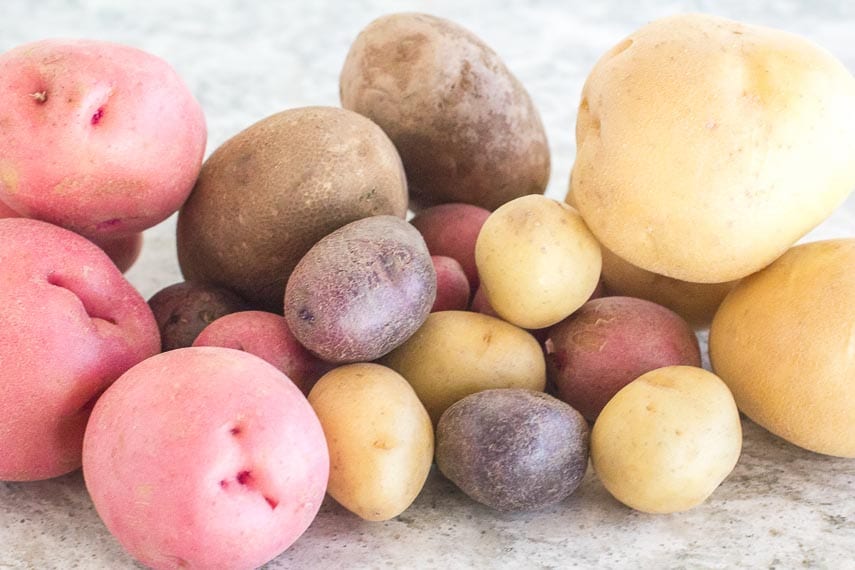
The Good News – Potatoes Are No/Low FODMAP
Whether potatoes (Solanum tuberosum) contain any FODMAPs at all is a confusing topic, because for many years Monash University listed white, red, purple, and russet style potatoes all together in one entry in their smartphone app as containing no FODMAPs at all.
Then Monash changed the listing, created multiple listings for various potatoes, removed the “no FODMAPs have been detected in this food” and the “eat freely and according to appetite” language, and made a distinct serving size suggestion. So what are you supposed to think?
Please pause to read our article When Monash University and FODMAP Friendly Low FODMAP Lab Test Results Differ for a more thorough explanation.
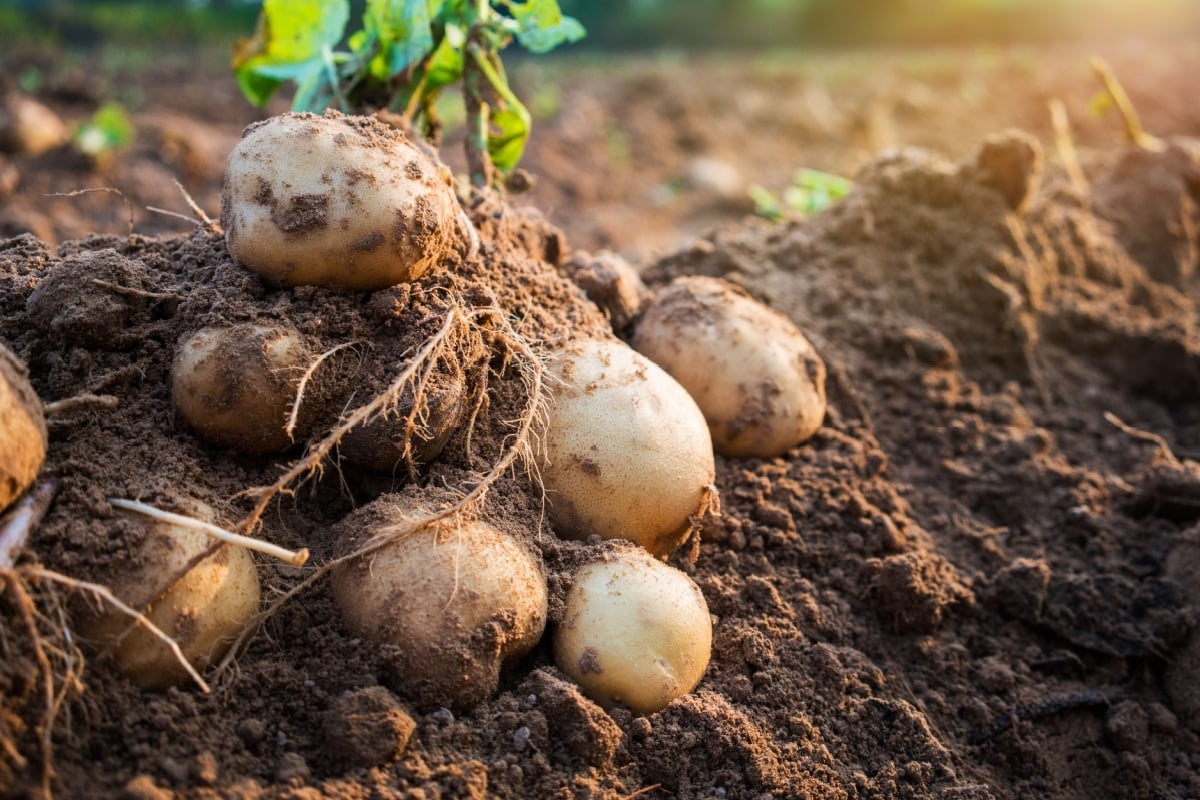
Potatoes: Lab Test Results
- Yellow Potatoes & Red Potatoes: Currently the Monash University app has separate entries for yellow potatoes and red potatoes, each suggesting a low FODMAP serving size is 75 g (which they state as ½ cup).
- White Potatoes: FODMAP Friendly has an entry for white potatoes. GOS is listed as the FODMAP they found in white potatoes. Their serving size suggestion is 122 g (which they say is one medium potato) with a max low FODMAP serving of 407 g (now updated to 488 g).
The current Monash University app entries (one for yellow, one for red potatoes) only show a Green Light low FODMAP serving, with no Yellow or Red Light amounts. The small print says that the food remains low FODMAP up to 500 g. That is over a pound. Please note that this is the upper amount tested; it is not meant to suggest that they are higher FODMAP at 501g.
Reading our article How To Use The Monash University Low FODMAP Diet App will be very helpful.
You can read more about the FODMAP Friendly app and how they lab test foods in our article FODMAP Friendly Lab Testing Explained.

So, Are Potatoes No FODMAP, or Low FODMAP?
Both. Since we know that Monash, at one point, detected no FODMAPs in their potato lab tests, we know that it is possible for potatoes to contain no FODMAPs. Subsequent lab tests indicated that potatoes can contain FODMAPs (GOS according to FODMAP Friendly), but the serving sizes are generous.
When you read the article linked above about why lab tests differ you will understand that the potatoes you buy today, or next week, will be different from those lab tested, and you can use any of the lab test findings as a place to begin your exploration of potatoes and how you digest them from a FODMAP perspective.
All lab tests are accurate and represent what was tested at the time. One limitation of the Monash University and FODMAP Friendly apps is that only one data set can be shown at a time. In addition, the fruits and vegetables you buy literally cannot be the same as those tested at any time. Use the app entries as guides, and not absolutes.
Potato Facts
Potatoes are part of the nightshade family, as are tomatoes and eggplant. Nightshades are not an issue from a FODMAP perspective.
There are close to 4,000 varieties of potato and they were first documented as far back as 8000 BC. Note that we do not know what varieties either of the testing bodies took into the labs, so again, the ones you buy are going to be different than what were lab tested in those snapshots of time.
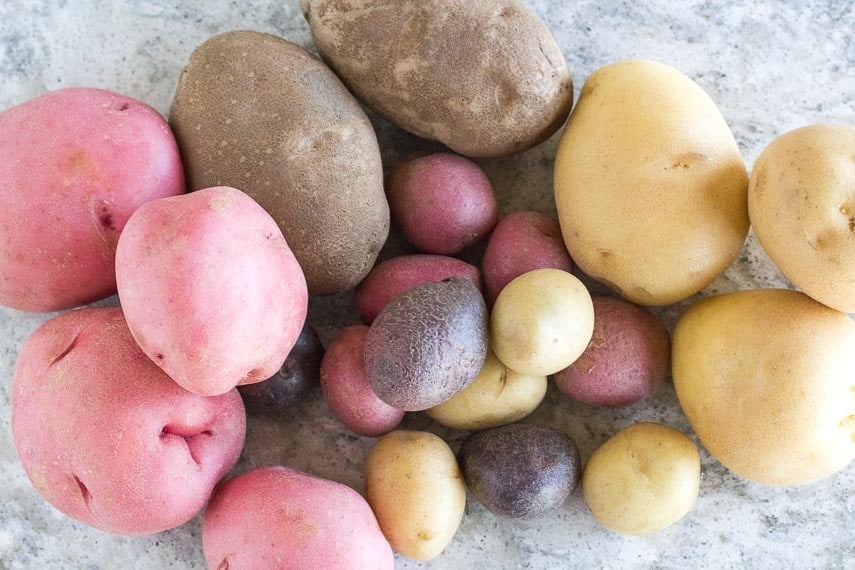
Also Known As…
In some parts of the world potatoes might be referred to as spuds, tatties or taters.
Sweet Potatoes
Sweet potatoes (Ipomoea batatas) are only distantly related to the potatoes described above. See an image of sweet potatoes below.
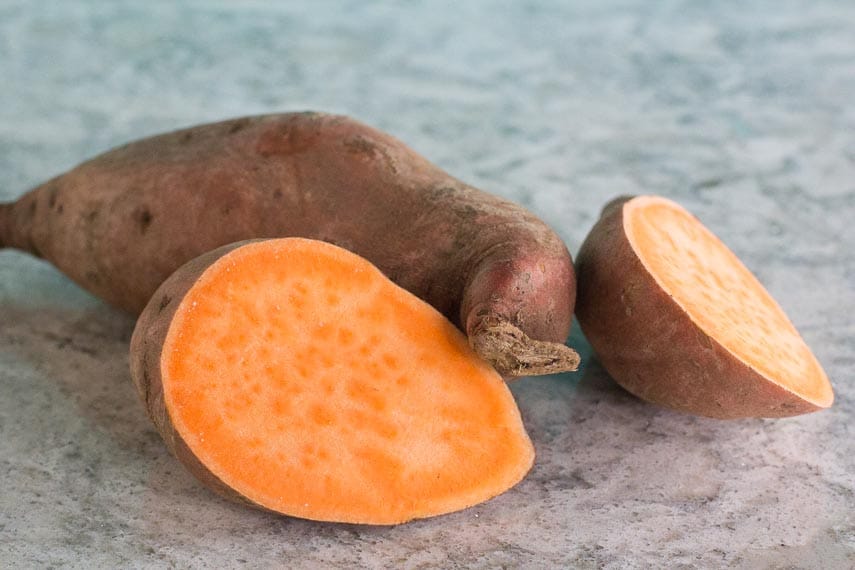
Monash Lab Testing
- Sweet Potatoes: The Monash app listing for sweet potatoes gives us Green Light low FODMAP portions of ½ cup (75 g) and Yellow Light moderate FODMAP portions of 2/3 cup (100 g).
- White Kumara sweet potatoes: Monash has lab tested white kumara sweet potatoes, unpeeled, their low FODMAP serving size is 75 g; they become Moderate for fructans at 140 g, and High FODMAP at 175 g.
- Purple Kumara sweet potatoes: Monash has lab tested purple kumara sweet potatoes, unpeeled, their low FODMAP serving size is 75 g; they become Moderate for fructans at 150 g, and High FODMAP at 189 g.

- Orange flesh sweet potato: Currently, the FODMAP Friendly app lists orange-fleshed sweet potatoes with a low FODMAP serving size is ½ cup (75 g) as well. Max serving size is 250 g, now updated to 375 g. They also have an identical listing titled “Yam, fresh”; see Yam section below.
- Purple skin, white flesh sweet potato: In an older iteration of the FODMAP Friendly app, they showed lab-testing of purple skinned, white fleshed sweet potatoes and they said a low FODMAP serving size is ½ cup (75 g) as well.
- White skinned, purple flesh sweet potatoes: FODMAP Friendly also has lab tested white skinned, purple flesh sweet potatoes and a low FODMAP serving size is 75 g, with a max serve of 516 g.

As always, YOUR tolerance is what is important, so assessing your own reactions during a structured Challenge Phase is paramount.
Please read our article, What Is A Low FODMAP Serving Size?, which will be helpful.
What About Yams?
For sweet potatoes in particular, note that Monash and FODMAP Friendly have lab tested orange fleshed sweet potatoes, which are often labeled as “yams” in U.S. markets.

True yams (Dioscorea alata; see above) are a different vegetable, FYI. Monash University has tested them.
- Yams: low FODMAP in 1 cup (75 g) portions, but do not hit Yellow Light moderate until 2 cup (300 g) portions.
FYI the New Zealand yam is Oxalis tuberosa. You can see them below. They have not been lab tested.

How to Buy
For all potatoes we recommend buying in bulk so that you can hand pick each potato.
Potatoes often come pre-bagged, and might even be less expensive this way, but you have no assurance that you will not end up with bruised or rotten potatoes.
Potato skin should be blemish free, with no sprouting eyes or rotting areas.
Don’t Buy Green Potatoes
If potatoes are sporting a green color, do not buy them.
A green color on potato skins indicates that they have been stored exposed to light – either sunlight or even fluorescent light – and the color indicates the presence of solanine, which is a natural toxin that can trigger digestive upset.
How to Store
Potatoes should be stored in a well-ventilated cool, dark place.
Temperatures of about 45°F to 50°F (7°C to 10°C) are best for short-term storage and most potatoes will last in the average home for a couple of weeks.
Proper storage should prevent the development of any green color and retain their texture.
Do not refrigerate. Temperatures below 39°F (4°C) will convert the starches to sugar, which alters their taste, texture and how they react during cooking.
Any potatoes that are soft, mushy, develop a green cast, grow extensive eyes or show any rotten areas should be discarded.
How to Prep
If you have any potatoes at home that have developed a greenish cast, there are a few approaches to consider.
If there are a couple of sprouted eyes (see below) or small spots that have turned green, you can trim them away and still use the potato.
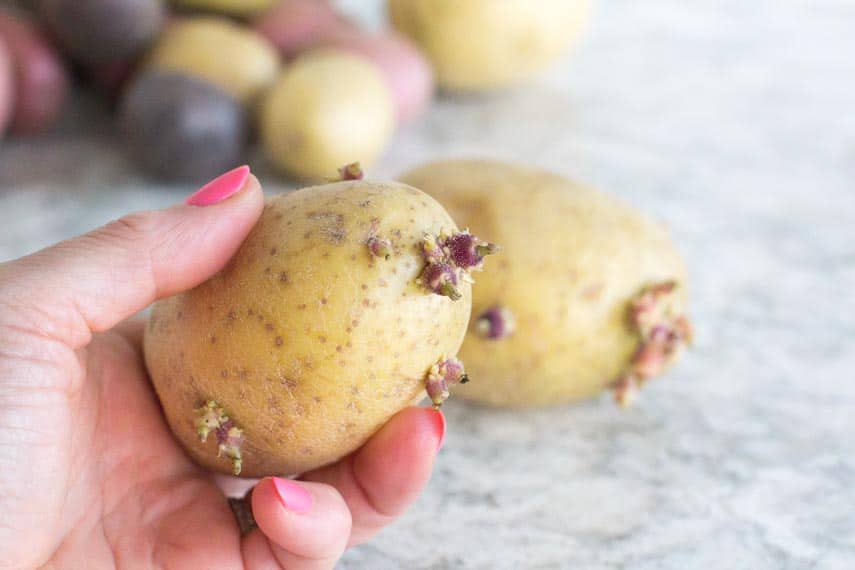
But if the potato has developed a green cast over a larger area, discard the potato.
All potatoes should be washed right before using and not before.
Starchy potatoes, such as Russets and Idaho potatoes are often peeled, although they do not have to be. They do always need a good scrub, as they can be quite dirty and dusty.
Waxier potatoes can be used with the skin, which is tender, or they, too, can be peeled.
Once peeled they should be used right away or you can store them in cold water, which will remove some of the starch, which will leach into the water. Follow individual recipes for directions and sometimes you want to remove the starch and sometimes you need it.
Depending on your final usage you might want to excess starch removed or not, so use this technique only when appropriate and directed to do so.
How to Cook
Let us count the ways! Boiled, steamed, pan-fried, sautéed, baked, nuked in the microwave, deep-fried, grated, shredded, julienned, mashed, smashed, cold in salads, made into chips, fries or potato pancakes, hash browns or home fries…potatoes are versatile!
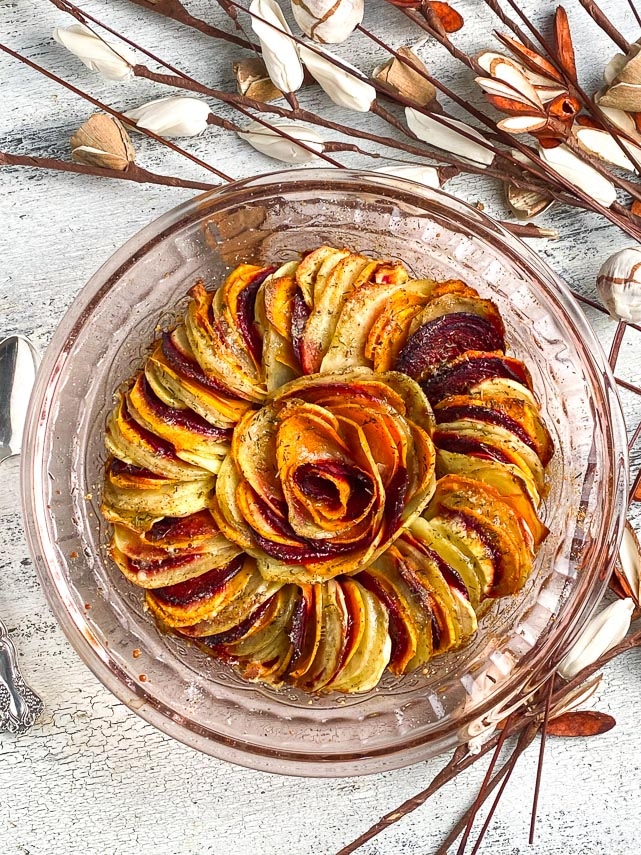
Low FODMAP Potato Recipes
We have many low FODMAP recipes for you, including:
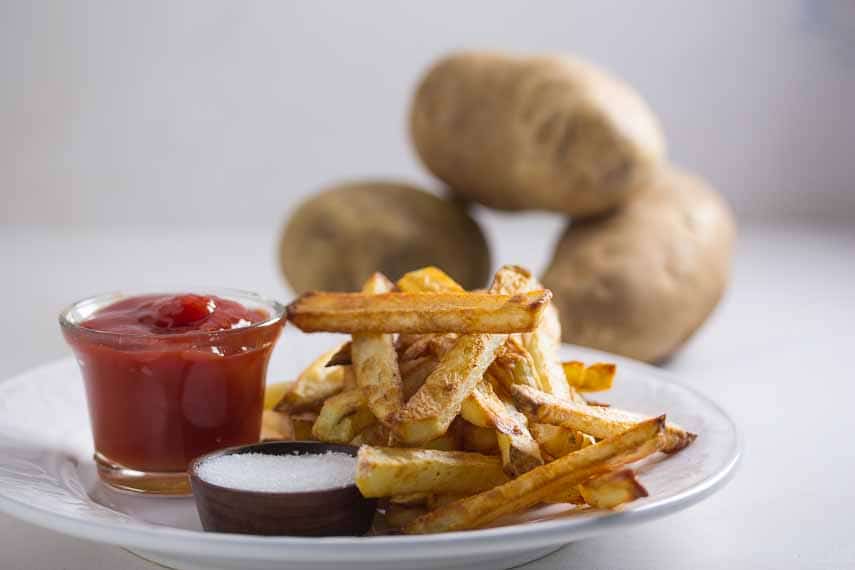
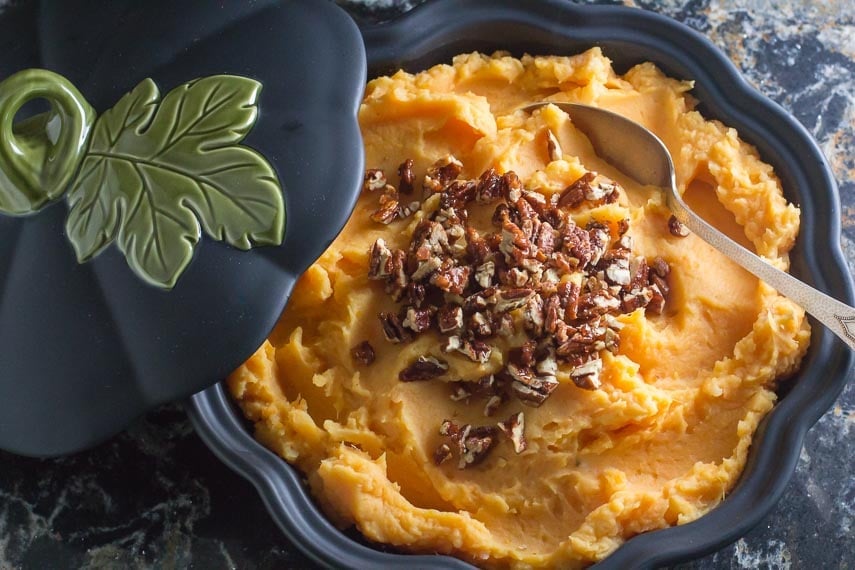
- Mashed Sweet Potatoes
- Vegan Mashed Potatoes
- Low FODMAP Mashed Potatoes with Sour Cream & Chives
- Low FODMAP Berbere Spiced Mashed Potatoes, Parsnips & Carrots
- Low FODMAP Colcannon (seen below)
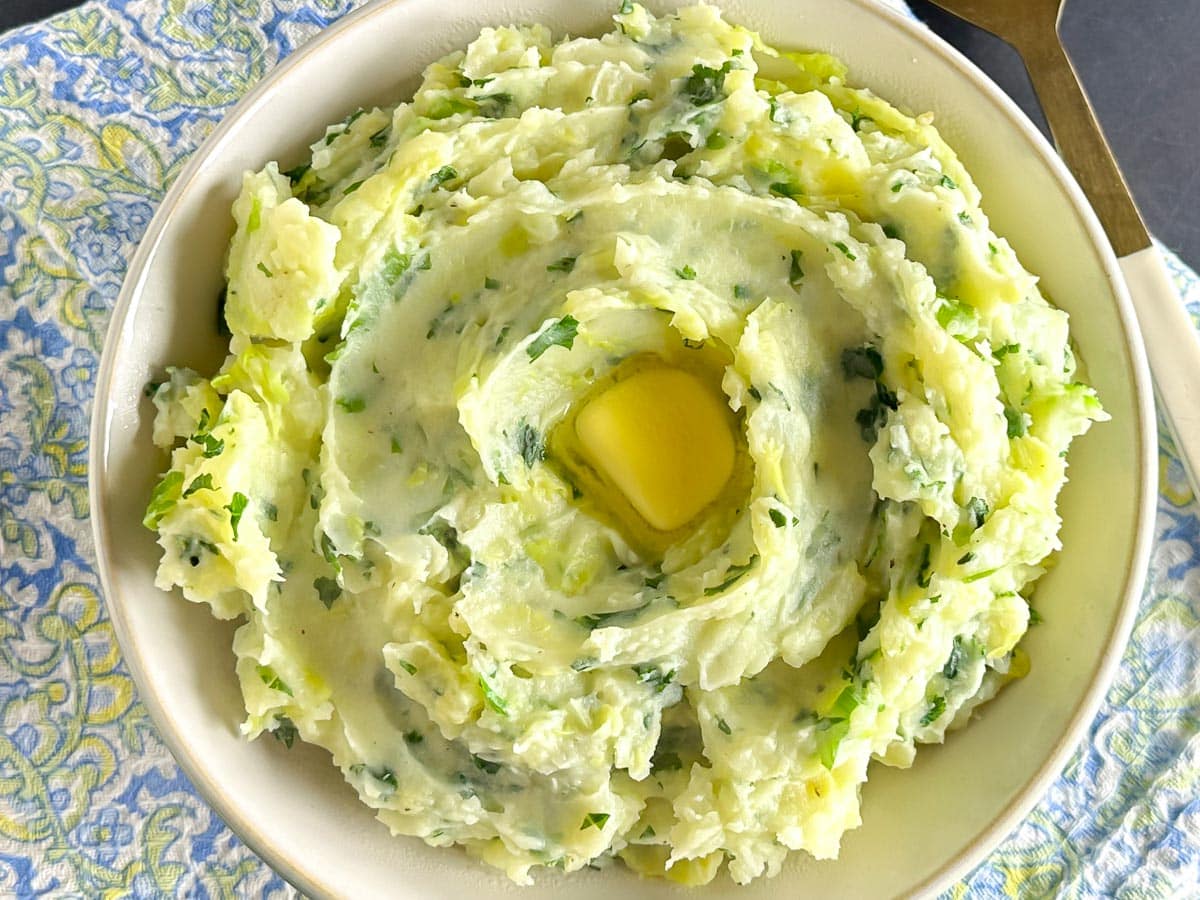
And MANY potato salads including classic with hardboiled eggs, a tangy one with pickles, one with bacon and chives, featured in a salade Nicoise and so many more.
Now, go cook some fabulous low FODMAP food with no and low FODMAP potatoes!

